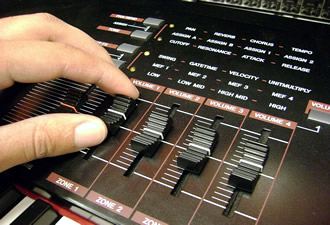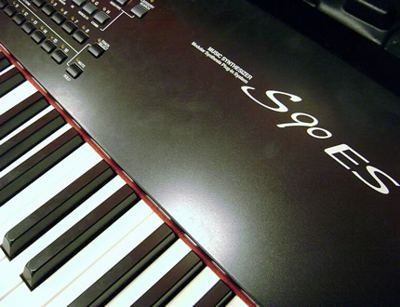
Introduction
When the Yamaha S90ES made its debut in August of 2005, it marked a quantum leap forward in digital piano and synthesis technology. Putting aside its Motif ES roots and all its other capabilities, the S90ES is the best feeling and sounding digital piano/synth we have ever played so far.
Overview
First things first. Yamaha has marketed this keyboard as the "perfect balance between synthesizer and digital piano". This is definitely an accurate statement. The S90ES has one of the smoothest, best feeling weighted keyboard actions we've ever played on a synth. The pitch bend, mod wheels, and real-time sliders show off the S90ES's synth side. In addition, the Yamaha S90ES has 128 notes of polyphony (not including the extra polyphony you can add with any optional plug-in expansion boards), and over 500 programs utilizing the 228 MB of high quality waveforms driven by the AWM2 24-bit DSP chip.
If you are already familiar with the Yamaha Motif then you will be at home with the S90ES. The S90ES retains familiar menus, such as, voice, performance, and master modes for editing your sounds and global settings. Plus, the S90ES sound banks are organized very much alike.
Keyboard Feel
The Yamaha S90ES's keyboard action is a balanced hammer mechanism with aftertouch. We loved the feel of this keyboard; its silky smooth response allows the musician a wide dynamic range of volume from ppp-fff. For an 88-key synth/digital piano, the S90ES is very light weighing in at only 22.5kg (49lbs, 10oz) making the S90ES a great keyboard for the traveling musician.
Sounds
The S90ES's sound banks are arranged categorically, similar to the Motif's convenient sound banks—A. Piano, Keyboard, Organ, etc. We were blown away with the Yamaha S90ES's sounds, particularly, the S90ES's brand new piano samples. These piano samples are exclusive to the Yamaha S90ES and make up 53 MB out of the 228 MB sample soundest. These piano samples were recorded from the Yamaha S700—a $250,000 grand piano. (We did research on the S700 and couldn't find any info and concluded that the S700 is a piano Yamaha built for sampling purposes—not production). Only the most discerning ear will be able to tell this piano apart from the real thing. The S90ES synthesizes sympathetic resonance effects and also allows you to use half-damper pedaling techniques with the optional Yamaha FC3 damper pedal. The Yamaha S90ES is also compatible with the FC4, FC5, FC7, and BC3 damper pedal, footswitch, expression pedal and breath controller.
Among other sounds that impressed us were the pads, electric pianos, synth leads, strings and orchestral instruments. Plus, Yamaha took the time to program controllers such as the mod wheel, data sliders, and aftertouch into many of the sound bank programs, creating a wealth of valuable and playable sounds for sparking new song ideas.
Programmable Controllers
The Yamaha S90ES has the flexibility to allow you to program controllers to affect a single or even multiple parameters of your programs at once. For example, you could assign the mod wheel to control LFO pitch depth and panning, thus allowing you to simultaneously control pitch depth and panning with just one controller.
The S90ES's four sliders, mod wheel, pitch wheel, breath, switch, and, foot controllers are all assignable. With a touch of a single button, Yamaha made pre-assigned functions for the sliders. For example, if you were to press the PAN/SEND button, the sliders would control pan, reverb, chorus, and tempo. However, if you pressed the TONE button, the sliders would now control cutoff, resonance, attack, and release parameters. Very cool.
Other Features
Among other things, the Yamaha S90ES has a built-in sequencer but only for playing back SMF type 0 midi files. Also, if you have an external sequencer, the S90ES can be used as a multi-timbral tone generator. A feature we found that came in handy was the REMOTE button. This allows you to control sequencer software on your computer from the S90ES's panel.
To wrap up, the Yamaha S90ES also includes an arpeggiator with over 1700 styles, three slots for expanding the S90ES sounds with the optional modular synthesis plug-in boards, and the optional mLAN16E board which effectively routes your MIDI and audio data to a single IEEE 1394 connection eliminating the need for dozens of cables.
Conclusion
The Yamaha S90ES has one of the nicest 88-weighted key actions we've seen on a Yamaha keyboard. The piano sounds are stunningly gorgeous and very playable—we couldn't stop playing them! Aside from the pianos, the rest of the sounds are what you would expect from a Motif except without the Motif price tag. We liked the flexibility and expandability of the S90ES as well as its light weight; however, we wished it at least came with a footswitch pedal and had a built-in recording sequencer for those of us who aren't using software sequencers yet. It would be nice if Yamaha came out with an S90ES rack module version in the future for those of us who already have a dedicated 88-key controller too.
The Yamaha S90ES is perfect for the professional musician who needs the right piano and synth controller that could be used as the main instrument in their studio while being portable enough to be placed in the backseat of a Honda if needed. The S90ES is indeed the perfect balance between synthesizer and digital piano.


